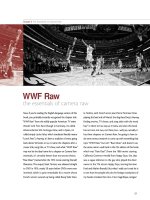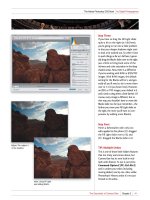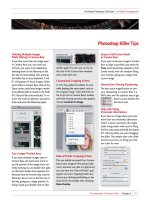The Adobe Photoshop CS5 Book for Digital Photographers part 16 pps
Bạn đang xem bản rút gọn của tài liệu. Xem và tải ngay bản đầy đủ của tài liệu tại đây (1.74 MB, 10 trang )
ptg
131Chapter 5How to Resize and Crop Photos
The Adobe Photoshop CS5 Book for Digital Photographers
Continued
Step One:
Go under the File menu, under Scripts,
and choose Image Processor. By the way,
if you’re working in Adobe Bridge (rather
than Photoshop), you can Command-
click (PC: Ctrl-click) on all the photos
you want to apply the Image Processor
to, then go under the Tools menu, under
Photoshop, and choose Image Processor.
That way, when the Image Processor
opens, it already has those photos
pegged for processing. Sweet!
Step Two:
When the Image Processor dialog opens,
the first thing you have to do is choose
the folder of photos you want it to “do
its thing” to by clicking on the Select
Folder button, then navigating to the
folder you want and clicking Choose
(PC: OK). If you already have some photos
open in Photoshop, you can click on the
Use Open Images radio button (or if you
choose Image Processor from Bridge, the
Select Folder button won’t be there at
all—instead it will list how many photos
you have selected in Bridge). Then, in the
second section, decide whether you want
the new copies to be saved in the same
folder or copied into a different folder.
No big whoop (that’s a technical term).
If you have a bunch of images that you need resized, or converted from TIFFs
to JPEGs (or from PSDs to JPEGs, for that matter), then you will love the built-in
Image Processor. It’s kind of hidden in a place you might not expect it (under
the Scripts menu), but don’t let that throw you—this is a really handy, and
really easy-to-use, totally automated tool that can save you tons of time.
Automated Saving
and Resizing
Download from www.wowebook.com
ptg
132
Chapter 5 How to Resize and Crop Photos
The Adobe Photoshop CS5 Book for Digital Photographers
Step Three:
The third section is where the fun
begins. This is where you decide how
many copies of your original you’re
going to wind up with, and in what
format. If you turn on the checkboxes
for Save as JPEG, Save as PSD, and Save
as TIFF, you’re going to create three
new copies of each photo. If you turn
on the Resize to Fit checkboxes (and
enter a size in the Width and Height
fields), your copies will be resized, too
(in the example shown here, I chose
a small JPEG of each file, then a larger
TIFF, so in my folder I’d find one small
JPEG and one larger TIFF for every file
in my original folder).
Step Four:
In the fourth section, if you’ve created
an action that you want applied to your
copies, you can also have that happen
automatically. Just turn on the Run Action
checkbox, then from the pop-up menus,
choose which action you want to run.
If you want to automatically embed your
copyright info into these copies, type
your info in the Copyright Info field.
Lastly, there’s a checkbox that lets you
decide whether to include an ICC pro-
file in each image or not (of course, I’m
going to try to convince you to include
the profile, because I included how to
set up color management in Photo shop
in Chapter 12). Click the Run button,
sit back, and let it “do its thing,” and
before you know it, you’ll have nice,
clean copies aplenty.
Download from www.wowebook.com
ptg
133Chapter 5How to Resize and Crop Photos
The Adobe Photoshop CS5 Book for Digital Photographers
Continued
Step One:
Open the photo you want to resize,
then go under the Image menu and
choose Image Size. When the Image
Size dialog appears, in the Pixel
Dimensions section at the top, to
the right of the Width field, you’ll
see a pop-up menu where Pixels is
chosen (if this section isn’t active,
turn on the Resample Image check-
box at the bottom). Click on that
menu and choose Percent (as shown
here). Both the Width and Height will
change to Percent, because they’re
linked together by default.
So, since you saw earlier how much resolution you need to have to create a
decent-sized print, how do photographers get those huge poster-sized prints
without having super-high-megapixel cameras? It’s easy—they upsize the images
in Photoshop, and the good news is that unless you need to resize your image by
more than 300%, you can do this all right in Photoshop without having to buy a
separate resizing plug-in (but if you need more than a 300% size increase, that’s
where those plug-ins, like OnOne Software’s Genuine Fractals, really pay off).
Resizing for
Poster-Sized
Prints
SCOTT KELBY
Download from www.wowebook.com
ptg
134
Chapter 5 How to Resize and Crop Photos
The Adobe Photoshop CS5 Book for Digital Photographers
Step Two:
Now type in either 200% or 300%
(although there is some debate about
this, it seems to work best if you move
up/down in 100% increments) in the
Width field (again, since they’re linked,
the Height field will automatically
change to the same number).
Step Three:
At the bottom of the dialog is a pop-up
menu that decides which algorithm is
used to upsize your photo. The default
is Bicubic (Best for Smooth Gradients),
and I use that for most everyday resizing
stuff, but when it comes to jumping
in big increments, like 200% or 300%,
I switch to Bicubic Smoother (which
Adobe says is “Best for Enlargements”),
as shown here.
Download from www.wowebook.com
ptg
135Chapter 5How to Resize and Crop Photos
The Adobe Photoshop CS5 Book for Digital Photographers
Step Four:
My buddy (and Epson printing expert)
Vincent Versace breaks this rule. Accord-
ing to Vincent’s research, the key to his
resizing technique is to not use the
sampling method Adobe recommends
(Bicubic Smoother), but instead to choose
Bicubic Sharper, which he feels provides
better results. So, which one is the right
one for you? Try both on the same image
(that’s right—just do a test print), and see
if you can see a visible difference. Here’s
the final image resized to nearly 28x42"
(you can see the size in the rulers by
pressing Command-R [PC: Ctrl-R]).
Download from www.wowebook.com
ptg
136
Chapter 5 How to Resize and Crop Photos
The Adobe Photoshop CS5 Book for Digital Photographers
Step One:
Open the photo that needs straightening.
Choose the Ruler tool from Photoshop’s
Toolbox (it look s like a little ruler, and
it’s hidden behind the Eyedropper tool,
so just click-and-hold for a moment on
the Eyedropper tool until the Ruler tool
appears in the flyout menu). Try to find
something in your photo that you think
is supposed to be straight or relatively
straight (the horizon, in this example).
Click-and-drag the Ruler tool horizontally
along this straight edge in your photo,
starting from the left and extending to
the right.
Step Two:
Now, just click the Straighten button
up in the Options Bar (it’s shown circled
here in red), and you’re done. Not only
has it straightened your photo, but it has
cropped off any white space left by the
straightening, too.
Straightening
Crooked Photos
There have always been workarounds for straightening images in Photoshop,
but they were always just that—workarounds. Now, in Photoshop CS5, there
finally is a dedicated feature that makes the process really fast and simple.
SCOTT KELBY
Download from www.wowebook.com
ptg
137Chapter 5How to Resize and Crop Photos
The Adobe Photoshop CS5 Book for Digital Photographers
Continued
Downsizing photos where the
resolution is already 300 ppi:
Although earlier we discussed how to
change image size if your digital camera
gives you 72-ppi images with large physi-
cal dimensions (like 24x42" deep), what do
you do if your camera gives you 300-ppi
images at smaller physical dimensions (like
a 10x6" at 300 ppi)? Basically, you turn on
Resample Image (in the Image Size dialog
under the Image menu), then simply type
in the desired size (in this example, we
want a 6x4" final image size), and click OK
(don’t change the Resolution setting, just
click OK). The image will be scaled down
to size, and the resolution will remain at
300 ppi. IMPORTANT: When you scale
down using this method, it’s likely that
the image will soften a little bit, so after
scaling, you’ll want to apply the Unsharp
Mask filter to bring back any sharpness
lost in the resizing (go to Chapter 11 to
see what settings to use).
There’s a different set of rules we use for maintaining as much quality
as possible when making an image smaller, and there are a couple of
different ways to do just that (we’ll cover the two main ones here).
Luckily, maintaining image quality is much easier when sizing down than
when scaling up (in fact, photos often look dramatically better—and
sharper—when scaled down, especially if you follow these guidelines).
Making Your
Photos Smaller
(Downsizing)
Download from www.wowebook.com
ptg
138
Chapter 5 How to Resize and Crop Photos
The Adobe Photoshop CS5 Book for Digital Photographers
Making one photo smaller without
shrinking the whole document:
If you’re working with more than one
image in the same document, you’ll
resize a bit differently. To scale down
a photo on a layer, first click on that
photo’s layer in the Layers panel, then
press Command-T (PC: Ctrl-T) to bring
up Free Transform. Press-and-hold the
Shift key (to keep the photo proportional),
grab a corner point, and drag inward.
When it looks good, press Return (PC:
Enter). If the image looks softer after
resizing it, apply the Unsharp Mask filter.
TIP: Reaching the Free
Transform Handles
If you’re resizing a photo on a layer using
Free Transform and you can’t reach the
handles (because the edges of your photo
extend outside the image area), just press
Command-0 (PC: Ctrl-0), and your
window will automatically resize so you
can reach all the handles—no matter
how far outside your image area they
once were. Two things: (1) This only works
once you have Free Transform active, and
(2) it’s Command-0—that’s the number
zero, not the letter O.
SCOTT KELBY
Download from www.wowebook.com
ptg
SCOTT KELBY
139Chapter 5How to Resize and Crop Photos
The Adobe Photoshop CS5 Book for Digital Photographers
Resizing problems when
dragging between documents:
This one gets a lot of people, because
at first glance it just doesn’t make sense.
You have two documents, approximately
the same size, side-by-side onscreen. But
when you drag a 72-ppi photo (a USAF
Thunderbirds jet) onto a 300-ppi docu-
ment (Untitled-1), the photo appears
really small. Why? Simply put—resolu-
tion. Although the documents appear
to be the same size, they’re not. The tip-
off that you’re not really seeing them at
the same size is found in each photo’s
title bar. Here, the jet image is displayed
at 100%, but the Untitled-1 document
below is displayed at only 25%. So, to get
more predictable results, make sure both
documents are at the same viewing size
and resolution (check in the Image Size
dialog under the Image menu).
TIP: Automated Cropping
& Straightening
Want to save time the next time you’re
scanning prints? Try gang scanning (fitting
as many photos on your flatbed scanner
as will fit and then scan them as one big
single image), and then you can have
Photo shop automatically straighten each
individual image and place it into its own
separate document. You do this by going
under the File menu, under Automate, and
choosing Crop and Straighten Photos.
No dialog will appear. Instead, Photoshop
will look for straight edges in your photos,
straighten the photos, and copy each into
its own separate window (by the way, it
seems to work best when the photos you
scan as a group have similar tonal qualities.
The more varied the colors of the photos
are, the harder time it seems to have
straightening the images). This automa-
tion also works on single, crooked images.
Download from www.wowebook.com
ptg
140
Chapter 5 How to Resize and Crop Photos
The Adobe Photoshop CS5 Book for Digital Photographers
Step One:
Create a new document at 8x10" and
240 ppi. Open a digital camera image,
get the Move tool (V), and drag-and-
drop it onto the new document, then
press Command-T (PC: Ctrl-T) to
bring up Free Transform. Press-and-
hold the Shift key, then grab a corner
point and drag inward to scale the
image down, so it fits within the 8x10"
area (as shown here), and press Return
(PC: Enter). Go under the Edit menu
and choose Content-Aware Scale
(or press Command-Option-Shift-C
[PC: Ctrl-Alt-Shift-C]).
Step Two:
Grab the top handle, drag straight
upward, and notice that it stretches the
sky upward, but pretty much leaves
the man intact, without stretching
or bloating him. If you keep dragging
upward, it will start dragging him, so
you can’t drag forever, but luckily you
see a live onscreen preview, so you’ll know
how far you can drag. When you’ve
dragged far enough, press Return to lock
in your change. (Note: The button that
looks like a person in the Options Bar
tells Content-Aware Scale that there are
people in the photo, so it avoids anything
with a skin tone. It doesn’t always work,
but it’s worth a try.)
Resizing Just Parts
of Your Image
Using “Content-
Aware” Scaling
We’ve all run into situations where our image is a little smaller than the area
where we need it to fit. For example, if you resize a digital camera image so it
fits within a traditional 8x10" image area, you’ll have extra space either above or
below your image (or both). That’s where Content-Aware Scaling comes in—
it lets you resize one part of your image, while keeping the important parts
intact (basically, it analyzes the image and stretches, or shrinks, parts of the
image it thinks aren’t as important). Here’s how to use it:
SCOTT KELBY
Download from www.wowebook.com









